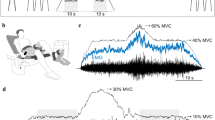Abstract
The organization and pattern of cutaneous reflex modulation is unknown during rhythmic cyclical movements of the human upper limbs. On the assumption that these cyclic arm movements are central pattern generator (CPG) driven as has been suggested for leg movements such as walking, we hypothesized that cutaneous reflex amplitude would be independent of electromyographic (EMG) muscle activation level during rhythmic arm movement (phase-dependent modulation, as is often the case in the lower limb during locomotion). EMG was recorded from eight muscles crossing the human shoulder, elbow, and wrist joints while whole arm rhythmic cyclical movements were performed. Cutaneous reflexes were evoked with trains of electrical stimulation delivered at non-noxious intensities (∼2 × threshold for radiating paresthesia) to the superficial radial nerve innervating the lateral portion of the back of the hand. Phasic bursts of rhythmic muscle activity occurred throughout the movement cycle. Rhythmic EMG and kinematic patterns were similar to what has been seen in the human lower limb during locomotor activities such as cycling or walking: there were extensive periods of reciprocal activation of antagonist muscles. For most muscles, cutaneous reflexes were modulated with the movement cycle and were strongly correlated with the movement-related background EMG amplitude. It is concluded that cutaneous reflexes are primarily modulated by the background muscle activity during rhythmic human upper limb movements, with only some muscles showing phase-dependent modulation.
Similar content being viewed by others
References
Brooke JD, Mcllroy WE, Collins DF (1992) Movement features and H-reflex modulation. I. Pedalling versus matched controls. Brain Res 582:78–84
Brooke JD, Cheng J, Collins DF, McIlroy WE, Misiaszek JE, Staines WR (1997) Sensori-sensory afferent conditioning with leg movement: gain control in spinal reflex and ascending paths. Prog Neurobiol 51:393–421
Brooke JD, McIlroy WE, Staines WR, Angerilli PA, Peritore GF (1999) Cutaneous reflexes of the human leg during passive movement. J Physiol (Lond) 518:619–628
Brown DA, Kukulka CG (1993) Human flexor reflex modulation during cycling. J Neurophysiol 69:1212–1224
Brown DA, Kautz SA, Dairaghi CA (1996) Muscle activity patterns altered during pedaling at different body orientations. J Biomech 29:1349–1356
Brown DA, Kautz SA, Dairaghi CA (1997) Muscle activity adapts to anti-gravity posture during pedalling in persons with post-stroke hemiplegia. Brain 120:825–837
Caccia MR, McComas AJ, Upton ARM, Blogg T (1973) Cutaneous reflexes in small muscles of the hand. J Neurol Neurosurg Psychiatry 36:960–977
Chen R, Ashby P (1993) Reflex responses in upper limb muscles to cutaneous stimuli. Can J Neurol Sci 20:271–278
Cheng J, Brooke JD, Misiaszek JE, Staines WR (1995) The relationship between the kinematics of passive movement, the stretch of extensor muscles of the leg and the change induced in the gain of the soleus H reflex in humans. Brain Res 672:89–96
Drew T, Rossignol S (1987) A kinematic and electromyographic study of cutaneous reflexes evoked from the forelimb of unrestrained walking cats. J Neurophysiol 57:1160–1184
Duysens J, Tax T (1994) Interlimb reflexes during gait in cat and human. In: Swinnen SP, Heuer H, Massion J, Casaer P (eds) Interlimb coordination: neural, dynamical, and cognitive constraints. Academic Press, San Diego, CA, pp 97–126
Duysens J, Van de Crommert HW (1998) Neural control of locomotion: the central pattern generator from cats to humans. Gait Posture 7:131–141
Forssberg H, Grillner S, Rossignol S (1975) Phase dependent reflex reversal during walking in chronic spinal cats. Brain Res 85:103–107
Komiyama T, Zehr EP, Stein RB (2000) Absence of nerve-specificity in human cutaneous reflexes during standing. Exp Brain Res 133:262–272
Ryan MM, Gregor RJ (1992) EMG profiles of lower extremity muscles during cycling at constant workload and cadence. J Electromyogr Kinesiol 2:69–80
Van Wezel BM, Ottenhoff FA, Duysens J (1997) Dynamic control of location-specific information in tactile cutaneous reflexes from the foot during human walking. J Neurosci 17:3804–3814
Winter DA (1991) The biomechanics and motor control of human gait. University of Waterloo Press, Waterloo, Ontario, Canada
Zehr EP, Stein RB (1999) What functions do reflexes serve during human locomotion? Prog Neurobiol 58:185–205
Zehr EP, Komiyama T, Stein RB (1997) Cutaneous reflexes during human gait: electromyographic and kinematic responses to electrical stimulation. J Neurophysiol 77:3311–3325
Zehr EP, Fujita K, Stein RB (1998a) Reflexes from the superficial peroneal nerve during walking in stroke subjects. J Neurophysiol 79:848–858
Zehr EP, Stein RB, Komiyama T (1998b) Function of sural nerve reflexes during human walking. J Physiol (Lond) 507:305–314
Author information
Authors and Affiliations
Corresponding author
Additional information
Published online: 22 August 2000
Rights and permissions
About this article
Cite this article
Zehr, E.P., Chua, R. Modulation of human cutaneous reflexes during rhythmic cyclical arm movement. Exp Brain Res 135, 241–250 (2000). https://doi.org/10.1007/s002210000515
Received:
Accepted:
Issue Date:
DOI: https://doi.org/10.1007/s002210000515




